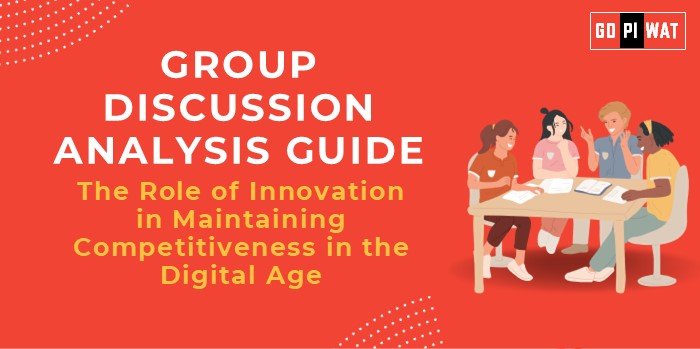📋 The Role of Innovation in Maintaining Competitiveness in the Digital Age
🌐 Introduction to the Topic
Opening Context: “In an era defined by technological disruption, companies must innovate to stay relevant and competitive. Digital transformation has accelerated global markets, pushing businesses to rethink strategies in areas such as automation, data analytics, and artificial intelligence.”
Topic Background: The digital age, starting in the late 20th century and catalyzed further by the 4th Industrial Revolution, has redefined global competition. The rise of innovative technologies like AI, IoT, and blockchain forces organizations to innovate continuously to survive.
📊 Quick Facts and Key Statistics
- 🌍 Global Digital Transformation Market: Valued at $880 billion in 2023, expected to grow to $3.2 trillion by 2030.
- 💰 R&D Spending: Companies in tech, such as Amazon and Alphabet, invest over 15% of annual revenue in innovation.
- 🤖 AI Adoption: By 2025, AI-driven businesses will contribute up to $15.7 trillion to the global economy (PwC).
- 🚀 Startup Growth: Over 25% of unicorn startups globally are AI or technology-focused, underscoring innovation’s role in competitiveness.
👥 Stakeholders and Their Roles
- 🏢 Corporations: Drive innovation through research and product development to stay ahead.
- 🏛️ Government Bodies: Support innovation via funding, policies (e.g., Startup India, Digital Transformation Acts), and incentives.
- 🛍️ Customers: Push demand for better services and products, enabling market competition.
- 🚀 Startups and Innovators: Disrupt industries with cost-effective, innovative solutions.
- 🌐 Tech Giants: Set benchmarks for innovation (e.g., Amazon, Google, Apple).
🏆 Achievements and Challenges
🌟 Achievements
- ⚡ Enhanced Efficiency: Companies leveraging AI, IoT, and automation report 30-40% productivity gains.
- 🏆 Global Leaders: Firms like Tesla (EVs), Amazon (cloud innovation), and Alibaba showcase the benefits of technological disruption.
- 📈 Economic Impact: Innovation contributes to 21% of GDP growth globally (World Economic Forum).
⚠️ Challenges
- 👩💻 Skill Gaps: A lack of skilled workforce limits innovation.
- 💰 High Costs: Innovation requires significant investments, especially in R&D.
- 🌍 Digital Divide: Unequal access to technology in emerging economies slows competitiveness.
🌍 Global Comparisons
- 🇰🇷 South Korea: Ranked among the top in innovation due to its 4% GDP allocation for R&D.
- 🇺🇸 USA: Home to 60% of global technology companies driving innovation.
📖 Case Study
📝 Tesla: A pioneer in electric vehicles and autonomous technology, Tesla’s innovation made it a market leader, showcasing innovation’s power to disrupt traditional industries.
🗣️ Structured Arguments for Discussion
- ✅ Supporting Stance: “Innovation fuels businesses to remain competitive by improving efficiency, reducing costs, and enhancing customer satisfaction.”
- ❌ Opposing Stance: “Innovation-driven competitiveness is not sustainable without skilled talent and equitable technological access.”
- ⚖️ Balanced Perspective: “While innovation drives competitiveness, governments and companies must address challenges like workforce readiness and affordability.”
💡 Effective Discussion Approaches
📌 Opening Approaches
- 📊 Start with Statistics: “With innovation contributing to 21% of GDP growth globally, businesses must innovate to thrive in a competitive market.”
- 📖 Reference Case Studies: “Companies like Tesla, Amazon, and startups in AI have redefined entire industries through innovation.”
↔️ Counter-Argument Handling
- 📉 Challenge: “Innovation is costly and limited to large firms.”
- 📈 Rebuttal: “Open innovation and public-private partnerships enable even small businesses to innovate.”
📋 Strategic Analysis of Strengths and Weaknesses
📊 SWOT Analysis
- 💪 Strengths: Rapid adoption of AI and automation; investments in R&D and infrastructure.
- ⚠️ Weaknesses: Uneven technological penetration; skill shortages in emerging markets.
- 🌟 Opportunities: 5G, cloud computing, and AI adoption; strategic collaborations for knowledge transfer.
- 🚧 Threats: Technological disruptions causing job losses; cybersecurity challenges.
🎓 Connecting with B-School Applications
- 📂 Real-World Applications: Leverage AI to optimize supply chains in operations and explore blockchain in financial systems.
- 📘 Finance: Innovations like blockchain in financial systems.
- 💡 Sample Interview Questions:
- ❓ “What role does innovation play in maintaining a competitive edge for businesses like Amazon or Tesla?”
- ❓ “How can emerging economies bridge the innovation gap to compete globally?”
- 📖 Insights for B-School Students: Innovation aligns with project themes like digital transformation, AI integration, and entrepreneurship.


